Tomatoes are the perfect addition to any garden. Fresh tomatoes are delightfully tasty, and there are many ways to grow organic tomatoes.
Tomatoes were introduced to Europe by the Spanish who imported them when they invaded South America. Despite seeming quintessentially Italian, they were actually only introduced to Italy about 500 years ago.
They have an abundance of seeds and the seeds lasts for up to eight years if properly saved and stored. Tomatoes have traveled well and thrived in the Mediterranean climate.
In this article, I’ll discuss the many tomato varieties and how to grow organic tomatoes.
Organic Tomato Varieties
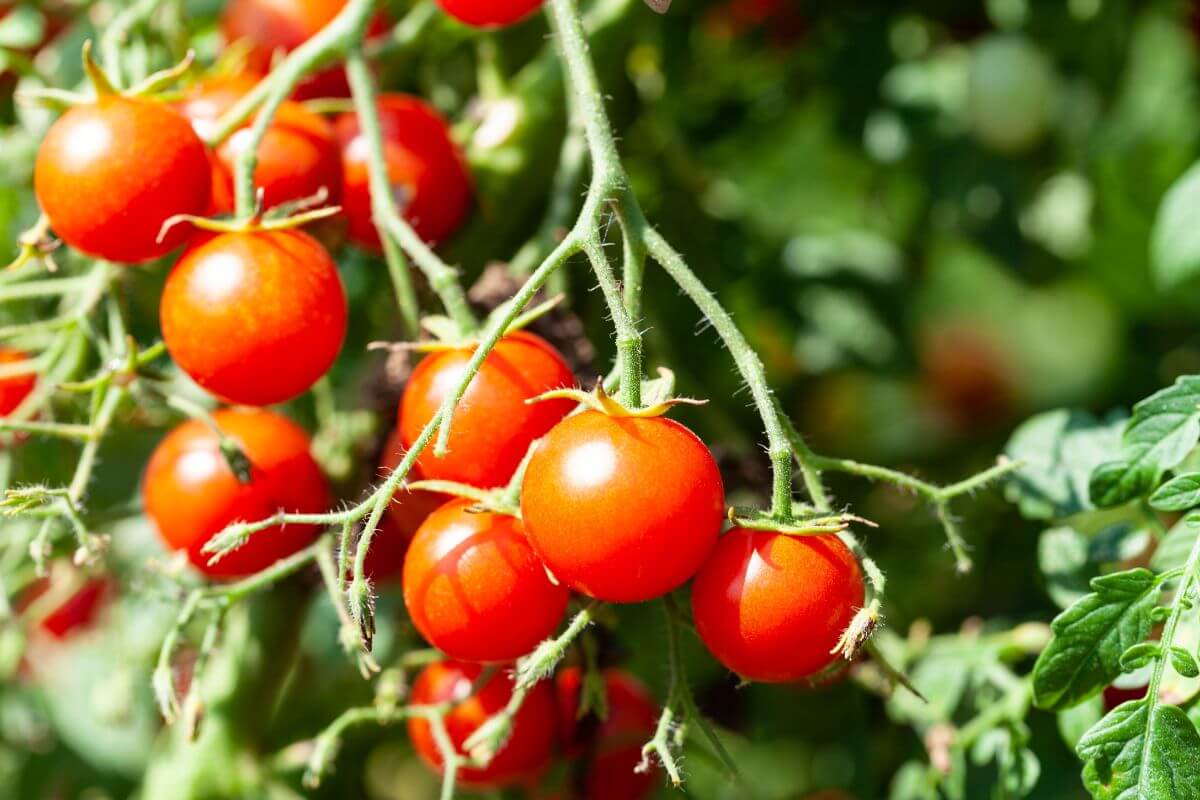
There are many, many varieties of tomato available. There is also an abundance of heirloom and open pollinated varieties, should you want to seed save or just try something different.
Tomatoes are low in calories and rich in vitamins C and K, potassium, folate, as well as a powerful antioxidant called lycopene. Lycopene has been linked to reducing the risk of heart disease and even some cancers.
I’m going to list a few popular types of tomato, so you to help you decide what type you want to grow.
There are many specific varieties that fall within these subcategories.
- Cherry Tomatoes – These small and sweet tomatoes are usually round and smaller than a golf ball. Grape tomatoes are even smaller and sweeter than cherry tomatoes.
- Salad / Slicing – These are the ‘regular’ tomatoes that you see in most grocery stores.
- Beefsteak Tomatoes – The largest type of tomato and have numerous small seed compartments.
- Plum / Roma Tomatoes – Oval or cylindrical in shape, these are usually used for paste, purée and sauce.
- Potato Leaf Tomatoes – These slicing tomatoes are distinctive for the fact that their leaves do not have the deep lobes that are usually associated with tomato plants.
Alongside these, you can also get all sorts of different combinations of these varieties. You should also check out heirloom varieties of tomatoes as they come in all sorts of colors, like yellow and even purple!
Most tomatoes are classified in one of two categories, bush or vine varieties. Bush and vine tomatoes are also known as determinate and indeterminate tomatoes, respectively.
Bush varieties will grow to about 3 or 4 feet in height. The side shoots flower and bear fruit quickly, so don’t need ‘pinching out’ with a trellis for support. Even though they’re not as lanky as vine varieties, they may still need a stake to support them.
Vine varieties can get up to 8 feet tall. Their side shoots don’t flower and grow very long, so they must be pinched out to ensure the fruiting upright stalk will grow. They need a tall stake, trellis, or string to support them.
Site and Organic Soil Preparation
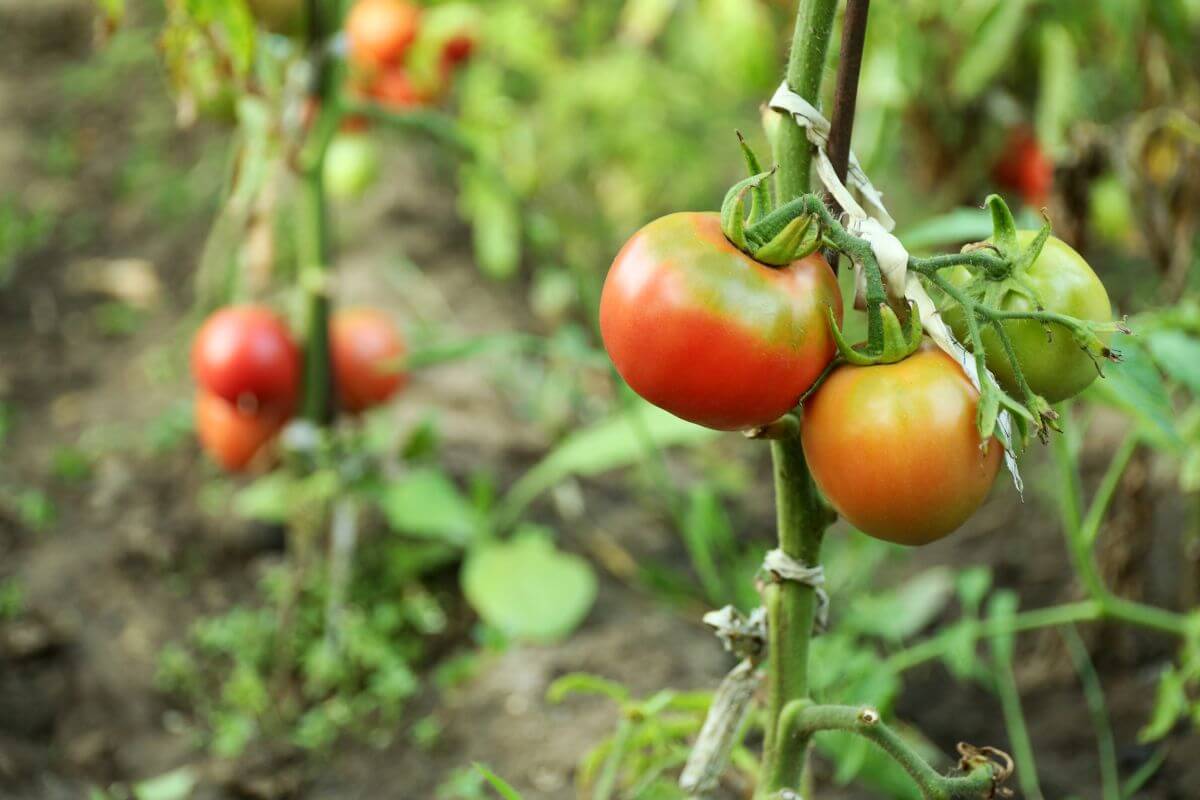
Tomatoes can be grown in pots, containers or directly in the soil. You can also get types that you can grow in hanging baskets.
Tomatoes need acidic soil with pH 6.0-6.8 levels, a lot of sunlight, and water.
Tomatoes like a sheltered and sunny spot. Experienced vegetable gardeners do tend to favor growing them in greenhouses in more temperate climates, as it extends the growing season.
Many gardeners will still grow outside, although they may start the tomatoes inside before transferring and replanting outside when temperatures are warmer. I’ll mention below how to start with planting tomatoes indoors and then transplanting them outside later.
Tomatoes need fertile, rich compost that is free of peat. If you’re growing into the ground, then dig in plenty of well rotted compost with the garden soil before you plant your tomatoes.
I like to plant tomatoes in compost-based soil the most, so I like to make I have plenty of compost on hand to keep potting them on as the tomatoes grow.
Remember to use organic materials like compost, manure, mulch and/or other organic fertilizers in your soil to grow tomato crop.
- Read more: Guide to Organic Soil Amendments
Planting Organic Tomatoes
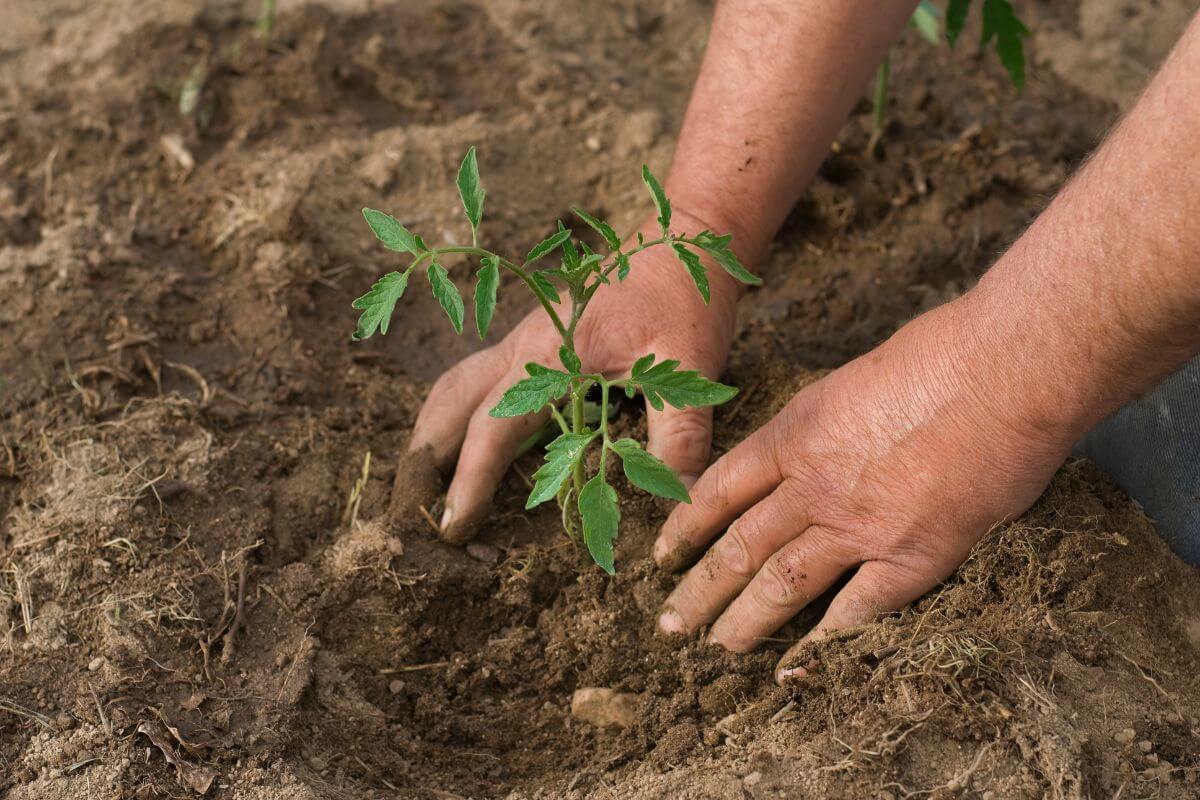
You can buy young tomato plants to jumpstart the growing process, but it’s easy to grow tomatoes from seed that you should start growing from seeds. Start your seeds from the end of January until the end of March.
You can use a propagator or a pot (or seed tray) covered in plastic wrap (cling film, saran wrap) on a warm window sill indoors or in your greenhouse. Start indoors since tomatoes take a longer time to mature as they’re warm-season plants.
When they reach 2-3 cm tall, transplant them to 5 cm pots filled with compost and return them to their warm and sunny spot.
Keep re-potting as needed until after the last frost, then move them outside to your outdoor garden. You can keep them in large containers or put them directly in the ground.
You can use a weed suppressing membrane to keep the soil moist and reduce weeds. Cover the area you are going to plant the tomatoes in the membrane fabric, then cut holes in it for your plants to be transplanted into.
Tomatoes grow well in the greenhouse, and can be either planted straight in the ground, pots, or containers.
When growing in the greenhouse, you will probably need to give them some shade. You can use blinds, shade paint, or hang up some woven fabric.
Basil likes the same conditions as tomatoes and is a great companion plant if growing in the greenhouse.
Growing Organic Tomatoes
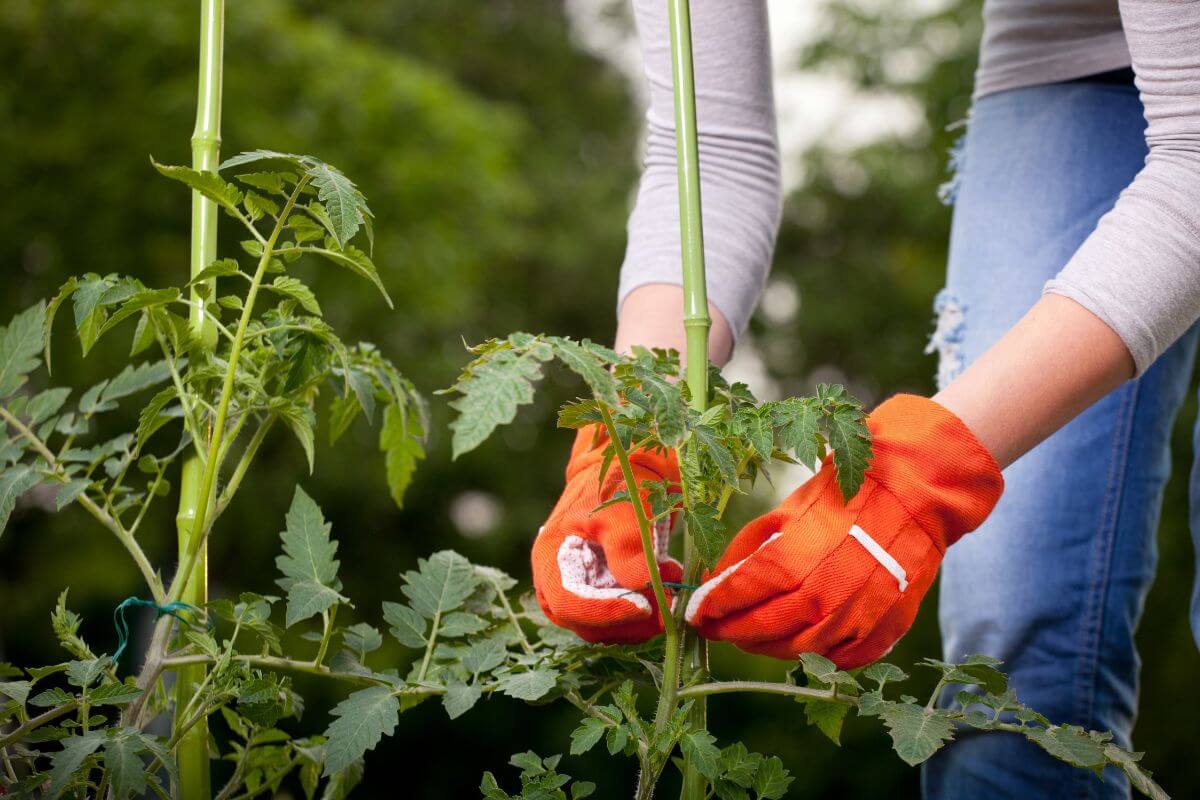
When it comes to determinate types and indeterminate types of tomatoes, there’s a lot of crossover with how to best grow tomatoes.
Vine Tomatoes / Indeterminate Tomatoes
If you’re growing vine tomatoes, you will have to remove the side shoots and use stakes to support them. Use canes and soft string to tie your plants to the canes. Tomato cages are also a good support option.
When they start to fruit, strip away some leaves to allow light to the fruits. Once you get four clusters of flowers, pinch out the growing tip of the plant.
When it comes to sunlight, smaller varieties like cherry tomatoes need at least 5-6 hours of sunlight. Larger tomatoes need more with at least 8-12 hours of sun.
The best temperatures for tomato plants is 18°C-24°C.
When the flowers appear, feed your plants weekly with liquid tomato feed, and keep your watering fairly regular. You can buy tomato feed or make your own by steeping comfrey leaves in water.
Tomatoes like plenty of water, so give them a good soak every couple of days. Try to water them in the morning before it gets too hot. A lack of water can cause rot and cracking in the tomato skin.
Tomato skin can crack in hot temperatures and less than ideal conditions, so do keep an eye on dry soil.
Bush Tomatoes / Determinate Tomatoes
Bush varieties tend to sprawl, but don’t need much care. Thin out foliage that’s blocking light to the fruits. You can use supports to stop the heavy fruits from snapping the stem.
They will also benefit from plant feed once a week, as well as regular watering. It is important to keep your watering regular as uneven watering can lead the fruits to split.
Growing in hanging baskets is a great space-saving idea, and perfect if you only have a small yard, or even just a balcony. Pests like slugs and snails find it hard to reach hanging baskets, so they can be pretty low maintenance.
Make sure you line your basket if it hasn’t got one already. Remember, you want it to retain moisture, but also allow the water to drain out as you don’t want the roots to be sitting in water.
Cherry and grape varieties are the best to grow in hanging baskets.
Pests and Diseases
Tomatoes can be affected by various pests, but there are also organic options for pest control:
- Aphids, whiteflies, and tomato hornworms can be sprayed with a mixture of organic liquid soap and water. If there aren’t very many, they can even be shaken loose by a jet of water.
- Cutworms can eat through the stem of young plants, and can be deterred by putting collars made of card, paper, or aluminum foil around seedling.
- Flea beetles eat the leaves and can be prevented by using row covers to protect young plants. In extreme cases, you can use diatomaceous earth or organic pesticides, but be aware that these can also harm beneficial bugs.
If you’d like to try companion planting, use marigolds as a natural aphid deterrent. Other beneficial companion plants are basil, dill, mint and parsley. They all repel insects and can improve the growth and flavor of your tomatoes.
Tomatoes suffer from a wide range of diseases, but not all of them are a problem for the backyard gardener. Keep an eye on your plants and you’ll be able to deal with any problems as soon as they arrive.
Tomato blight (or potato blight) is the most common tomato disease and usually occurs during wet summers. If you catch it early enough, you can try to stop the blight by removing any affected leaves.
If the blight has spread to the stem and fruit, then your only course of action is to remove any fruit you can salvage, and burn the damaged stems and fruit. If the salvageable tomatoes are green, you can still use them for chutneys.
Harvest and Store Organic Tomatoes
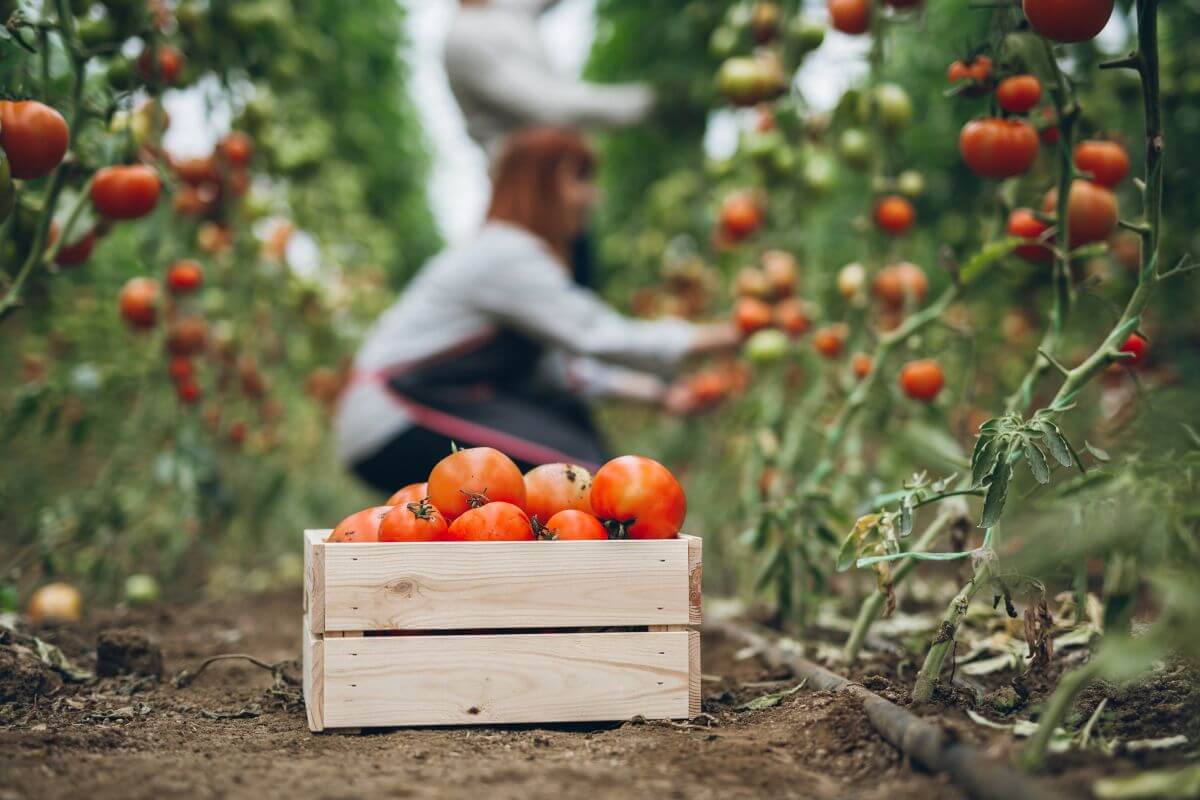
Allow tomatoes to ripen on the plant, as this improves flavor. Late in the growing season, remove any older leaves to let in more light and prevent any fungus growing.
When the weather turns colder, you can cut off the vines that still have unripe tomatoes and ripen them upside.
Tomatoes are best eaten fresh, straight off the plant. You can chop the ripe tomatoes and freeze them for use in sauces, but freezing does affect the texture.
Your best bet is to make the sauce and either freeze, bottle or can it. If you want to can whole tomatoes, then remove the skin first by blanching them in hot water.
Tomato seeds can be easily saved, but you will need to remove the gelatinous membrane by soaking them in water and then dry them properly before storing them.
When saving tomato seeds though, it’s best not to save the grocery store tomatoes as they’re most likely hybrid tomatoes. Hybrid tomato seeds will usually have unpredictable results, because the tomatoes are usually GMO tomatoes.
If you want to try seed-saving, check out my other article Saving Tomato Seeds.
How to Grow Organic Tomatoes Final Thoughts
Tomatoes are super tasty and defiantly worth the time growing them. Fresh, homegrown tomatoes taste so much better than store bought ones. They are so versatile that you’ll never be at a loss for what to do with them.
For guides on how to grow other organic plants, check these articles out:
- How to Grow Organic Potatoes
- How to Grow Organic Cucumbers
- How to Grow Organic Lettuce
- Tips on Organic Vegetable Gardening
To read more on open-pollinated and heirloom tomatoes, you can check out these articles
Growing Organic Tomatoes FAQs
What is the best organic fertilizer for tomatoes?
The best organic fertilizer for tomatoes is compost from organic materials. There are several types: aged manure, leaf compost, horse manure, chicken manure, and more. It’s important to make sure your tomato plants have enough nutrition, and are getting the right mix of minerals and vitamins too. A balanced fertilizer will give you the best results.
How do you increase yield on tomatoes organically?
The best way to increase yield on tomatoes using organic methods is by controlling diseases and pests, which reduces the need for continued fertilization over time. If you’re not seeing much growth, first look to spot treat areas of your garden that are suffering from a disease or pest. Secondly, start introducing a companion planting technique to either deter pests or attract beneficial bugs that prey on the pests. Lastly, add mulch around plant stems in order to alleviate soil compaction (which will allow plants to reach optimal height), as well as slow down water evaporation.
Are coffee grounds good for tomato plants?
Coffee grounds can be beneficial for tomato plants, but using too much can harm tomato plants. Coffee grounds contain nitrogen, which is a needed nutrient for tomato plants. The problem with coffee grounds is that they also have such high levels of acidity that the carbonic acid within them will quickly dissolve the nutrients from nearby areas. It’s best to add the coffee grounds to compost and allow it to age first.
Are banana peels good for tomato plants?
Yes, banana peels are good for tomato plants. They contain high amounts of potassium and phosphorus to produce healthier tomatoes. Banana peels also have calcium that will help to prevent blossom end rot.
Are eggshells good for tomato plants?
Eggshells are good for tomato plants, because they are a source of calcium, phosphorus, and potassium which helps the soil maintain better moisture balance.
How to identify organic tomatoes?
You can’t tell if tomatoes are organic just by looking at them. What you’ll need to do is to read its label for “USDA Organic” or its sticker number. Only the 5-digit numbers that begin with 9 means that its organic. 4-digit numbers mean that the food was grown traditionally, potentially with harmful pesticides and other chemicals.



